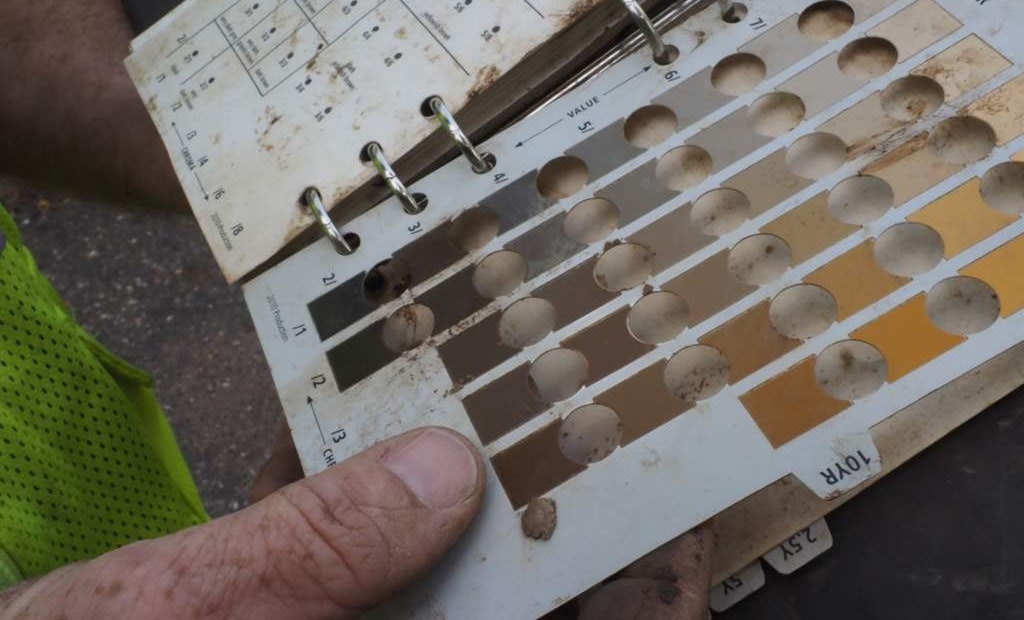
A Munsell color chart can be used to evaluate and compile data to classify soil type and characteristics.
Interested in Inspection?
Get Inspection articles, news and videos right in your inbox! Sign up now.
Inspection + Get AlertsOn every job site where excavation is occurring, one of the most important responsibilities for competent workers is accurately classifying soil.
OSHA’s “Subpart P, Appendix A” describes methods of classifying soils based on site and environmental conditions. The competent person is required to perform at least one visual and one manual test as a basis for classifying the soil. The soil type is then used to select a shielding, shoring protective system or sloping technique that will protect workers.
OSHA recognizes four types of soils:
Stable rock
OSHA defines stable rock as natural, solid mineral matter that can be excavated with vertical sides, and will remain intact while exposed. Stable rock is extremely rare. In fact, less than 2 percent of the soil in the U.S. is classified as stable rock. In addition, the process of excavating with saws, breakers or dynamite will likely fracture and destabilize material that was initially considered stable.
Type A soil
Cohesive soils with an unconfined compressive strength of 1.5 tons per square foot (tsf) (144 kilopascals (kPa)) or greater fall under Type A soil. Examples of cohesive soil include clay, silty clay, sandy clay, clay loam and, in some cases, silty clay loam and sandy clay loam. Cemented soils such as caliche and hardpan are also considered Type A. However, no soil is Type A if:
- The soil is fissured.
- The soil is subject to vibration from heavy traffic, pile driving from heavy traffic, pile driving or similar effects.
- The soil had been previously disturbed.
- The soil is part of a sloped, layered system where the layers dip into the excavation on a slope of four horizontal to one vertical or greater.
- The material is subject to other factors that would require it to be classified as a less stable material.
Type B soil
Cohesive soil with an unconfined compressive strength greater than 0.5 tsf (48 kPa) but less than 1.5 tsf (144 kPa) is Type B soil. Examples include:
- Granular cohesionless soils including angular gravel (similar to crushed rock), silt, silt loam, sandy loam and, in some cases, silty clay loam and sandy clay loam.
- Previously disturbed soils except those that would otherwise be classified as Type C soil.
- Soil that meets the unconfined compressive strength or cementation requirements for Type A but is fissured or subject to vibration.
- Dry rock that is not stable.
- Material that is part of a sloped, layered system where the layers dip into the excavation on a slope less steep than four horizontal to one vertical, but only if the material would otherwise be classified as Type B.
Type C soil
Type C soil is cohesive soil with unconfined compressive strength of 0.5 tsf (48 KPa) or less. Examples include:
- Granular soils including gravel, sand and loamy sand.
- Submerged soil or soil from which water is freely seeping.
- Submerged rock that is not stable.
- Material in a sloped, layered system where the layers dip into the excavation or slope of four horizontal to one vertical or steeper.
Soil Conditions Can Change
It is important to remember that soil conditions can change as time passes. The on-site competent person must constantly monitor soil conditions and assess whether additional precautions are necessary. A project might start in Type B soil, change to Type C, and then revert back to Type B.
In many instances, the competent person can simply classify the encountered soil as Type C, the least stable, and then shield, shore or slope accordingly.
About the Author: Matt Timberlake is president of Ted Berry Co. in Livermore, Maine.





